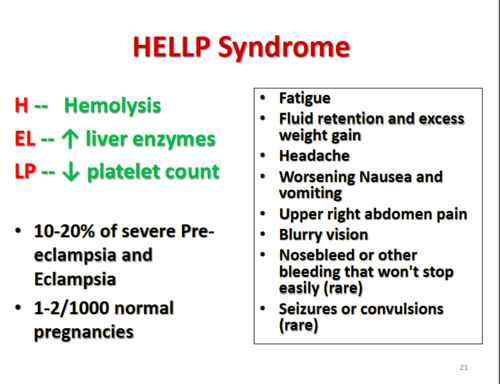A nurse is educating a client with mild pre-eclampsia about the signs and symptoms that she should report to her health care provider.
Which of the following should the nurse include? (Select all that apply.)
Sudden weight gain
Swelling of the face and hands
Epigastric pain
Decreased fetal movement
Vaginal bleeding
Correct Answer : C,D
The correct answer is choice C and D. Epigastric pain and decreased fetal movement are signs of severe pre-eclampsia that indicate damage to the liver and placenta respectively. These symptoms should be reported to the health care provider immediately as they may lead to serious complications such as eclampsia, HELLP syndrome, placental abruption or fetal growth restriction.
Choice A is wrong because sudden weight gain is a common symptom of mild pre-eclampsia that does not necessarily require immediate attention. However, it should be monitored regularly along with blood pressure and urine protein levels.
Choice B is wrong because swelling of the face and hands is also a common symptom of mild pre-eclampsia that does not indicate severe organ damage. It may be caused by fluid retention or edema.
Choice E is wrong because vaginal bleeding is not a typical symptom of pre-eclampsia. It may be a sign of other pregnancy complications such as placenta previa, placental abruption or cervical infection.
Nursing Test Bank
Naxlex Comprehensive Predictor Exams
Related Questions
Correct Answer is A
Explanation
This is because HELLP syndrome is a complication of pregnancy that affects the liver and blood clotting.It can cause liver damage, bleeding problems, and high blood pressure.Epigastric pain or right upper quadrant pain is a sign of liver injury or rupture.

Choice B is wrong because blurred vision or flashes of light are symptoms of preeclampsia, not HELLP syndrome.
Preeclampsia is a condition that causes high blood pressure and protein in the urine during pregnancy.It can lead to HELLP syndrome, but not all women with preeclampsia develop HELLP syndrome.
Choice C is wrong because decreased urinary output or oliguria are also symptoms of preeclampsia, not HELLP syndrome.
Oliguria means producing less than 400 mL of urine in 24 hours.It can indicate kidney damage or failure due to high blood pressure or proteinuria.
Choice D is wrong because hyperreflexia or clonus are also symptoms of preeclampsia, not HELLP syndrome.
Hyperreflexia means having exaggerated reflexes, while clonus means having involuntary muscle spasms.
They can indicate nervous system involvement or seizures due to high
Correct Answer is ["C","D"]
Explanation
The correct answer is choice C and D.Epigastric pain and decreased fetal movement are signs of severe pre-eclampsia that indicate damage to the liver and placenta respectively.These symptoms should be reported to the health care provider immediately as they may lead to serious complications such as eclampsia, HELLP syndrome, placental abruption or fetal growth restriction.
Choice A is wrong because sudden weight gain is a common symptom of mild pre-eclampsia that does not necessarily require immediate attention.However, it should be monitored regularly along with blood pressure and urine protein levels.
Choice B is wrong because swelling of the face and hands is also a common symptom of mild pre-eclampsia that does not indicate severe organ damage.It may be caused by fluid retention or edema.
Choice E is wrong because vaginal bleeding is not a typical symptom of pre-eclampsia.It may be a sign of other pregnancy complications such as placenta previa, placental abruption or cervical infection.
Whether you are a student looking to ace your exams or a practicing nurse seeking to enhance your expertise , our nursing education contents will empower you with the confidence and competence to make a difference in the lives of patients and become a respected leader in the healthcare field.
Visit Naxlex, invest in your future and unlock endless possibilities with our unparalleled nursing education contents today
Report Wrong Answer on the Current Question
Do you disagree with the answer? If yes, what is your expected answer? Explain.
Kindly be descriptive with the issue you are facing.
